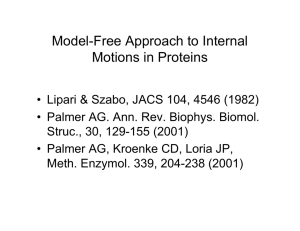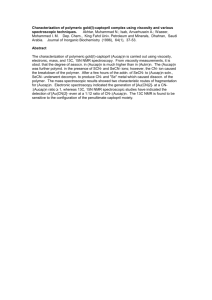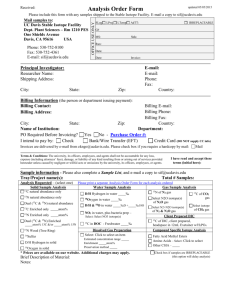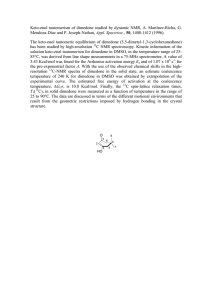Model-Free Approach to Internal Motions in Proteins
advertisement
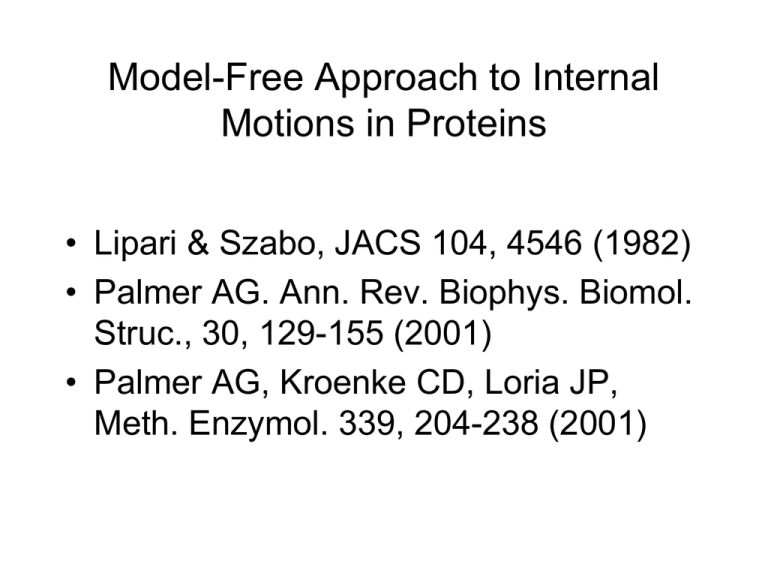
Model-Free Approach to Internal
Motions in Proteins
• Lipari & Szabo, JACS 104, 4546 (1982)
• Palmer AG. Ann. Rev. Biophys. Biomol.
Struc., 30, 129-155 (2001)
• Palmer AG, Kroenke CD, Loria JP,
Meth. Enzymol. 339, 204-238 (2001)
Generalized Order Parameters and
Internal Motion
Basis: fast internal motions scale interactions
that are then modulated by molecular tumbling
Methyl rotation a model specific example:
B0
H
’
H
H
’’
H1(t) (3cos2(’’(t) – 1)
H1(t) (3cos2(’(t) – 1)(3cos2( – 1)/2
H1(t) (3cos2(’(t) – 1)(-0.34)
H1(t) (3cos2(’(t) – 1) S
Order Parameter
Separate timescales can be introduced
for internal and overall motion
• Efficiency of relaxation due to tumbling is reduced
• Scaling factor is an “order parameter” – 0 if isotropic,
1 if no internal motion
2 S 2 m
(1 S 2 )
J ()
2
2
5 1 (m ) 1 ()
-1 = m-1 + i-1 , if I is very short, it dominates
For small first term can also dominate
• When is small, S2 and m can easily be measured for
proteins using 15N – 1H interactions (“r” is fixed at the bond
length and s are known)
2 S 2 m
(1 S 2 ) 2 S 2 m
~
J ( )
2
2
2
5 1 ( m ) 1 () 5 1 ( m )
• 15N T1 ,T2 , and heteronuclear NOEs are usually measured.
• m can be estimated from T1 ,T2 for a large molecule
1/T1 = (dd’/4)(J(I- S) + 3J(S) + 6J(I+ S))
1/T2 = (dd’/8)(4J(0)+J(I- S)+3J(S)+6J(I)+6J(I+ S))
•
•
•
•
(1/ T2) (dd’/8){4J(0)}, (1/ T1) (dd’/4){3J(N)}
J (2/5)S2 m / (1 + (m)2), (T1/ T2) (2/3)(mN)2
Once m is known, S2 can be calculated from T1 ,T2 or NOE
S2 in a structured region is about 0.8, in loops less
Example from binding of phosphopeptides to
SH2 domain Biochemistry, 33, 5987 (1994)
Changes in Order Parameters on Complexation
Internal Dynamics can Improve Resolution
– Cross-Correlation Effects
• TROSY - Pervushin, Riek, Wider & Wuthrich,
PNAS 94, 12366 (1997)
• TROSY na CRINEPT - Riek, Pervushin &
Wuthrich TIBS, 25, 462 (2000)
• C-N torsion angles -Reif, Hennig &
Griesinger Science, 276, 1230-1233 (1997)
TROSY, Example
15N
In a decoupled 1H, 15N HSQC spectrum,
each peak is an average of the four
multiplet components
Decoupled
HSQC
The S/N and line widths of the
individual multiplet components
are very different: each has different
contributions from CSA and
dipole-dipole coupling to T2
HSQC
(no decoupling)
TROSY selects for one of the
components -for this component,
the CSA and dipole-dipole
contributions nearly cancel one
another (highest S/N)
TROSY
Pervushin et al., Proc. Natl. Acad. Sci. USA 94, 1997
1H
CSA
DD
15N
CSA and 1H-15N Dipole Interactions Interfere
-Methyl Mannose Bound to
Mannose Binding Protein
Deuteration and TROSY Greatly Improve Resolution
Differential Line
Broadening due
to crosscorrelation
15N
HSQC
A
15N
TROSY
B
15N 2H
TROSY
C
Other Cross-Correlated Relaxation Phenomena
A general approach
•
•
•
•
•
1/T1,2 |V1|2 J11() + |V2|2 J22() + |V1 V2 | J12()
Jij() = fi(t + ) fj(t) exp(i)
If motions are uncorrelated, latter average is zero
Correlated example: 2 protons on a 13C methylene
Very geometry and motion dependent
Fields cancel
13C
1H
13C
1H
1H
1H
Fields cancel
Example: Acyl Chain Rotation in Lipid Bilayers
H
13C
H
+
13C
Heff = 0
13C
+
Heff = f(t)V
Selective Labeling of Methyl Groups
Provides Sensitivity and Resolution
Gardner &Kay (1997) JACS 119 7599
Goto et al. (1999) J Biomol NMR 13 369
Tugarinov & Kay (2003) JACS 125
13868
Methyl-TROSY
another example of cross-correlation effects
V. Tugarinov, R. Sprangers and L.E. Kay
J. Am. Chem. Soc. 126, 4921-4925 (2004)
Double and zero quantum coherences between 13C and 1H
evolve with the effects of coupling to the remaining 2 protons
Proton coupled ZQ (H-C) spectrum
1H
13C
1H
1H
αα
αβ/βα
ββ
Comparison of HMQC and HZQC Data
80 kDa malate synthase G – Kay et al, 2004
Other Contributions to T2 can Complicate
Analysis (Rex)
Extracting and Exploiting Rex is also Useful
• Structures of invisible, excited protein states by relaxation
dispersion NMR spectroscopy, Vallurupalli P, Hansen DF,
Kay LE, PNAS, 105, 11766-11771 (2008)
• Characterization of enzyme motions by solution NMR
relaxation dispersion, Loria JP, Berlow RB, Watt ED, Acc.
Chem. Res., 41, 214-221 (2008)
• Observing biological dynamics at atomic resolution using
NMR, Mittermaier AK, Kay LE, Trends Biochem. Sci., 34,
601-611 (2009)
NMR senses dynamics
on many time scales
Chemical exchange (Rex) is
particularly useful in the
100s- 10 ms range
Rex = ex pApBΔω2
ex-1 = A-1 + B-1
Mittermaier & Kay, Trends
Biochem. Sci (2009)
Carr-Purcell Meiboom-Gill Sequence Can
Remove Effects of Exchange
90x
2
180x
2
180x
2
180x
2
180x
2
180x
Long includes exchange; short removes exchange
Relaxation dispersion – a study as a function of
R2(1/τ) ) = R20 + ex/kex[1 - 2tanh(kexτ/2)⁄(kexτ)]
ex/kex = pApBΔω2
Field Dependent Measurement Separates
and PA,B information
(Kay, PNAS, 2008)
Detection of 5-10% minor species of
peptide bound to SH3 domain
